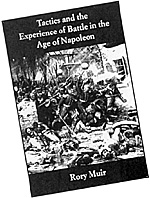
Author: Rory Muir
Pages: 342
Illustrations: 4 black and
white reproductions of period illustrations and
one tactical diagram.
Maps: None
Footnotes: 524
Appendices: One, a
Bibliographical Essay
Bibliography: 12 manuscript
sources, all British or Scottish, plus five
magazines and 468 published sources (mostly
books).
Index: 1,610 entries
Publisher: Yale University Press, New Haven, Connecticut
Publication Date: 1998
Binding: Cloth (hardbound)
ISBN: 0-300-07385-2
Price: $35.00
Summary: Tactics and
the Experience of Battle in the Age of
Napoleon successfully uses memoirs,
diaries and letters to explain what it was
like to be in battle from 1805-1815. It
clearly outlines how infantry, cavalry and
artillery functioned on a Napoleonic
battlefield. Although Anglocentric, Rory
Muir's well-written treatise sets a
standard for presenting the human
perspective of Napoleonic combat.
Readers may be familiar with Rory Muir's acclaimed work Britain and the Defeat of Napoleon, 1807-1815 (reviewed in Napoleon #9, page 51). The narrative of Tactics and the Experience of Battle in the Age of Napoleon, like that of his previous book, is a pleasure to read. Despite his scholar's credentials (he earned a Ph.D. at the University of Adelaide), Muir avoids "acadamese" and writes in a clear, unburdened manner.
Readers may find this book to be a useful complement to Brent Nosworthy's With Musket, Cannon & Sword: Battle Tactics of Napoleon and His Enemies (reviewed in Napoleon #2, page 27).
While Nosworthy concentrated on the history of tactical doctrine and the evolution of tactics on the Napoleonic battlefield, Muir investigated the "small picture" of how battle appeared to individual soldiers and their officers. Despite the similarity in titles, there is almost no overlap in material between the two books.
Muir explains in his preface that he was inspired by John Keegan's The Face of Battle (1976) which pioneered an original approach to the subject of combat by concentrating on the experiences of individual soldiers. Most books about battles and campaigns concentrate on what happened - the "big picture" - using lines and arrows on maps and statistics to study military events. Muir takes a different approach, investigating the nature of the fighting: how soldiers reacted upon coming under fire, what it felt like before and after a battle, what it was like to ride into a charge, what a general and his subordinates actually did to attempt to manage or control a seemingly chaotic situation, what happened when a unit finally broke and ran, etc. He shares these and many other fascinating specifics about Napoleonic battle with us, collected from hundreds of personal experiences.
The book is divided into four parts, with a total of thirteen chapters devoted to topics like The Eve of Battle, Light Infantry, The Role of the General, Morale and Cohesion, Attitudes and Feelings, and After the Fighting. Each chapter is filled with quotes and anecdotes, along with Muir's insightful analysis.
One other outstanding feature of Muir's book is the Bibliographical Essay. Most bibliographies list sources without comments or annotations. The story of how this book was put together, which sources were best and why, plus many other pieces of information about Napoleonic research make this appendix an incredibly useful guide.
The book uses English sources almost exclusively, and the perspective we get is nearly always that of the British soldier. Muir realized this might be a point of contention and addressed it in his preface by emphasizing that there is a rich collection of first-hand British accounts, many of them published and those of other nations are very scarce or lie buried in archives (if they exist at all). He points out that even Nosworthy's book had to rely on drill manuals and theoretical accounts due to the lack of detailed French reports about how tactics actually worked.
The Anglocentrism is the weakest part of the book. We learn much about fighting in the Peninsula and at Waterloo, but there are few personal accounts about the big battles fought in central Europe and Russia - Austerlitz, Jena, Leipzig, Borodino. However, this lack of national variety does not detract from the realistic picture of battle that Muir constructs. The truly definitive story of Napoleonic combat may have to wait until the experiences of many dozen French, German, Spanish, Austrian, and Russian soldiers can also be brought to light. Until then, this book will be the standard. Rory Muir has given Napoleonic combat a truly human perspective.
"As well as the smoke and noise -'weapons,
there were the screams of wounded men and horses, the
noise of drums and trumpets, -'men cheering, cursing
and weeping, exploding shells, bouncing cannon-balls,
dazed men wandering in search of their units or for
treatment Of their wounds, riderless and sometimes
horribly injured horses galloping about out Of control,
and the smell of gunpowder, blood, vomit, and human
excreta. All this acting on men raised to a high pitch of
excitement by the prospect -' action was enough to
overwhelm some soldiers who would take any opportunity
to slip away to safety in the rear; but most remained,
consoled by the reassuring presence Of their comrades.,
sustained by pride, and determined to see the battle
through to the end."
More Book Reviews
-
Book Review: Tactics and the Experience of Battle in the Age of
Napoleon
Book Review: Castiglione 1796
Book Review: Swords Around a Throne: Napoleon's Grande Armee
Book Review: History of the Waterloo Campaign
Back to Table of Contents -- Napoleon #13
Back to Napoleon List of Issues
Back to MagWeb Master Magazine List
© Copyright 1998 by Napoleon LLC.
This article appears in MagWeb (Magazine Web) on the Internet World Wide Web.
The full text and graphics from other military history magazines and gaming magazines are available at http://www.magweb.com
Order Napoleon magazine direct